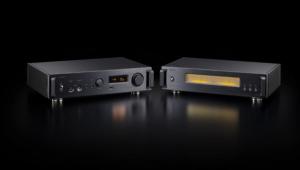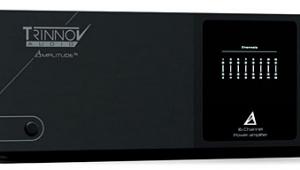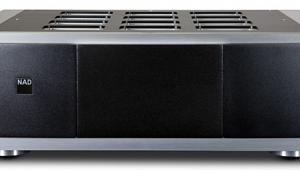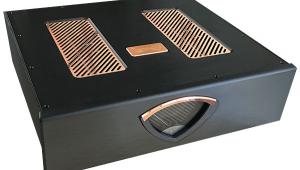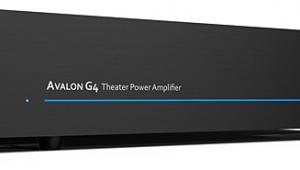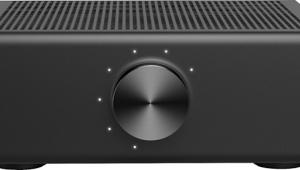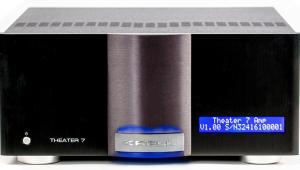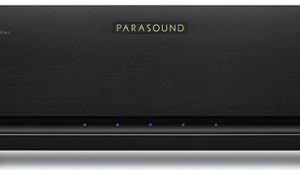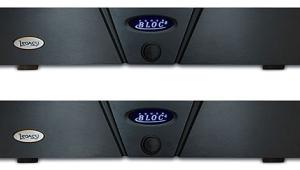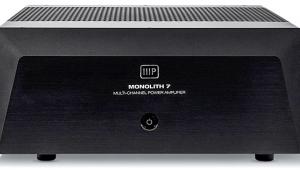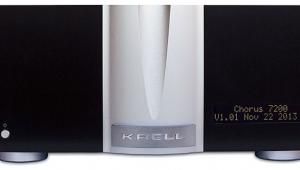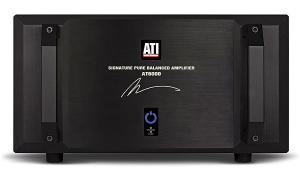Outlaw 950 & 770-preamplifier-processor & 7-channel power amplifier
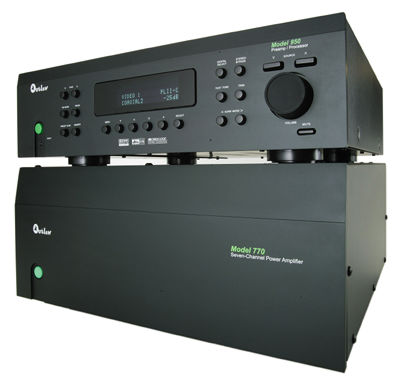
Reach for the Sky
The first feature of the Outlaw 950 pre-pro that you'll appreciate is its understated front panel. I normally cringe when confronted with the 101 similarly sized buttons crammed onto typical mass-market receivers, "secret" drop-down panels be damned—but the 950 looks like it's lifted from the same handbook of minimalist design used by NAD and Rotel. From the huge spinning Volume knob on the right to the appropriately outlandish, Crayola-green Power button on the left, the Outlaw will appeal to anyone old enough to remember 2-channel stereo.
The large LED display panel in the center is useful from up close (or from a distance, for those with 20/15 vision) for controlling the 950, or for setting it up, using the six navigational buttons directly below the display. I used the front panel just long enough to get the onscreen display (OSD) up on my Zenith TV; thereafter, I did almost everything else comfortably by remote control.
Outlaw's inclusion of an AM/FM tuner in the 950 brought back memories of an FM-only McIntosh MX-113 preamp-tuner I once owned. A great convenience, having a tuner built in, especially one of the caliber oft associated with McIntosh; with it, the 950 bears a strong resemblance to a full-fledged A/V receiver. AM or FM stations can be assigned to any of the 32 presets.
The 950 includes the latest array of surround-processing modes, selectable via two buttons on the front panel or four buttons on the remote. In addition to standard 5.1-channel Dolby Digital and DTS, the 950 has Dolby Digital Surround EX, which extracts a rear-center channel from matrix-encoded information contained in the two discrete rear channels. The 950 also has DTS-ES, which includes a Matrix mode that encodes the rear-center channel in the right and left surround channels, as well as a Discrete mode, for those DTS-ES DVDs in which the rear-center channel is a discrete track. In addition, Dolby Pro Logic and Pro Logic II are included for decoding 2-channel tracks found on older movies and much TV fare, as well as for simulating multichannel sound from 2-channel sources.
But only a small percentage of surround material has been recorded with that extra sixth channel (embedded or discrete). For the rest, the Outlaw 950 provides the Cirrus extensions (from the company that made the DSP chips in the unit). These are designed to simulate additional rear-surround channels for 6.1- or 7.1-channel playback from conventional DD 5.1 or DTS 5.1 recordings, or matrix formats like Dolby Pro Logic. The Cirrus extensions for such material appear as surround choices only if you've configured the 950 to include those additional rear-channel speakers. DTS Neo:6, another surround extension, is designed to create up to 6.1 channels from any 2-channel source, so it appears as a valid music or cinema surround choice regardless of the number of speakers for which the 950 is configured.
In addition to normal 2-channel stereo operations, the 950 also has a 5-channel stereo mode, for people who hate being alone. My favorite music modes, however, required no advanced processing. Stereo Bypass, available from the front panel or the remote, leaves your analog signal in the analog domain, where it belongs. This is what I used to play my vinyl (using an outboard phono stage, something Outlaw justifiably omits). Note, however, that unless you've specified the main speakers as Large (full-range), the digital signal processing (DSP) will remain active and generate a bass signal for the subwoofer to give you the best bass performance. If that offends you for some reason, you can always turn off the sub, but I found it worked very well in my setup. My other favorite surround mode is 6-channel direct, activated via the remote, which allowed me to enjoy multichannel SACD and DVD-Audio music from my Pioneer Elite DV-45A player.
With the exception of those two special bypass modes, Outlaw's universal learning remote offers one-button source selection. The rear panel has plenty of analog inputs, though you won't see a balanced input or output anywhere. As far as digital connections go, the 950 is limited to two coaxial inputs, which is, at best, a bare minimum, and at worst—as in my case—simply not enough. There are also four optical (TosLink) inputs. I ran my Zenith DTV-1080 set-top box (STB) and primary DVD player into the two coaxial inputs, but I was forced to switch to analog stereo cabling for a second DVD player. Add a favorite CD transport or digital laserdisc player to the rack, and you'll be forced to use the inferior TosLink connections if you want to remain in the digital domain for as long as possible. Only the good folks at RadioShack find TosLink superior to coaxial connections, and that's strictly for reasons of pronunciation.
The 950 offers sufficient S-video and composite inputs and outputs, but these are bandwidth-limited and non-uniform—I clearly saw differences in color saturation when I tried my STB's S-video output into various Outlaw inputs. The 950 has two component-video inputs that are said to have a bandwidth of 45MHz (–3db), which is more than enough for DVD or HDTV output from an STB. Unfortunately, I derive my high-definition signals from my STB's RGB outputs, and so I was unable to test the Outlaw's hi-def performance.
The 950's speaker-configuration options are unusually flexible for a product costing under $1000, and extraordinarily simple to adjust. First, you step through your speaker groups (Center, Front, Surround, Surround Rear), indicating whether each group is Small (crossovers will be used), Large (full-range), or nonexistent (except for the main left and right). You can also select quite a few crossover frequencies (40, 60, 80, 100, 120, and 150Hz) by individual speaker group—again, uncommonly accommodating for so affordable a product. A final flourish is hidden on the rear panel, where an Analog Bass Management switch lets you enable an 80Hz highpass filter across the five full-range multichannel inputs. Any sub-80Hz bass contained in those channels is summed and passed along, in the analog domain, to the subwoofer.
- Log in or register to post comments
